The per se atheist Chinese communist state issued quite some Buddhist theme stamps. Here they are.
I do this only for fun but I collected these stamps and always bought a few doubles which I can offer. Please request! (Please let me know if you know more Buddhist topic Chinese stamps!).
I don't collect ALL Chinese stamps but only the topics I am interested in. That is Tibet, Buddhism and birds.
For Chinese birds stamps go here,
and Tibetan theme stamps here.
Prices in EUR. Some stamps I will have to buy on demand.
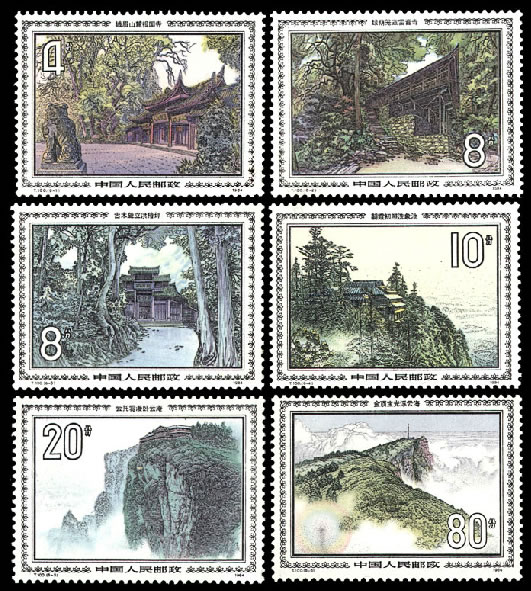 |
1984 T100 Scenes of Mount Emei Mount Emei (Chinese: 峨嵋山; pinyin: Éméi Shān is a mountain in Sichuan province, China. Mount Emei is one of the Four Sacred Buddhist Mountains of China, and is traditionally regarded as the place of enlightenment, of the bodhisattva Samantabhadra. Samantabhadra is known in Mandarin as Pǔxián Púsà (普賢菩薩). This is the location of the first Buddhist temple built in China in the 1st century CE. The site has seventy-six Buddhist monasteries of the Ming and Qing period, most of them located near the mountain top. The monasteries demonstrate a flexible architectural style that adapts to the landscape. |
9,00 |
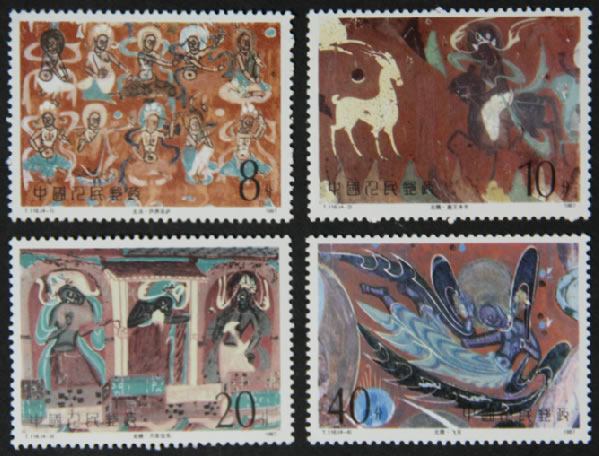 |
1987, T116 Dunhuang Murals (1st set) The Mogao Caves or Mogao Grottoes (Chinese: 莫高窟; pinyin: Mògāo kū), also known as the Caves of the Thousand Buddhas (Chinese: 千佛洞; pinyin: qiān fó dòng), form a system of 492 temples 25 km (16 mi) southeast of the center of Dunhuang, an oasis strategically located at a religious and cultural crossroads on the Silk Road, in Gansu province, China. The caves may also be known as the Dunhuang Caves, however, this term is also used to include other Buddhist cave sites in the Dunhuang area, such as the Western Thousand Buddha Caves, and the Yulin Caves farther away. The caves contain some of the finest examples of Buddhist art spanning a period of 1,000 years.[1] The first caves were dug out in 366 CE as places of Buddhist meditation and worship.[2] The Mogao Caves are the best known of the Chinese Buddhist grottoes and, along with Longmen Grottoes and Yungang Grottoes, are one of the three famous ancient Buddhist sculptural sites of China. |
5,00 |
 |
1987, T116M Dunhuang Murals (1st set) |
20,00 |
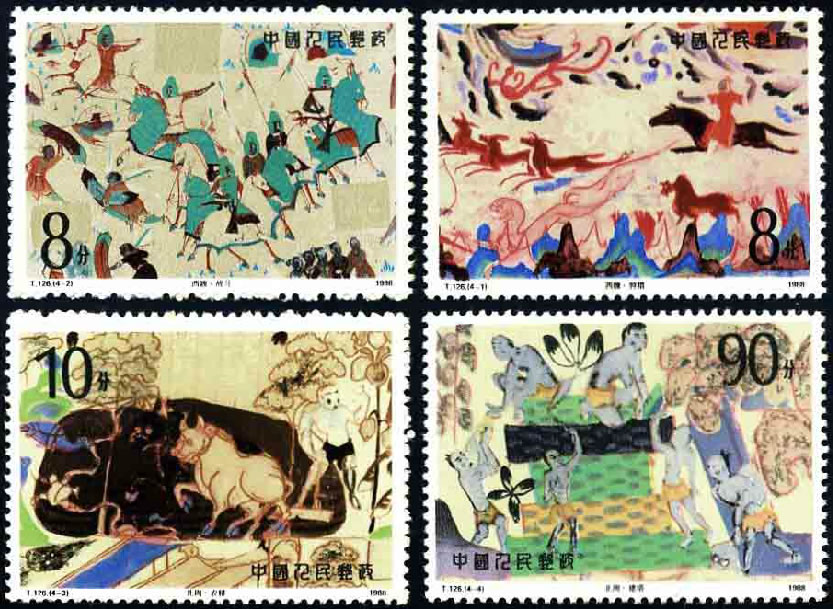 |
1988, T126 Dunhuang Murals (2nd set)
|
2,00 |
 |
1990 T150 Dunhuang Murals (3th Series) |
1,00 |
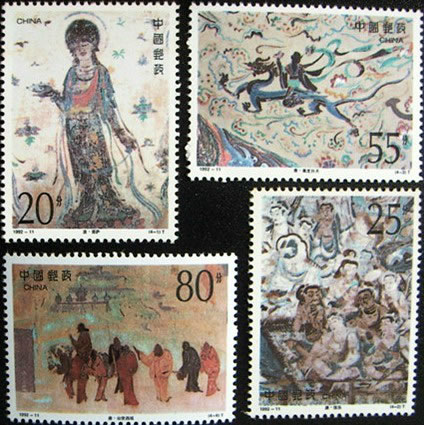 |
1992 1992-11 Dunhuang Murals (4th Series) |
2,00 (with sheet together 3,00) |
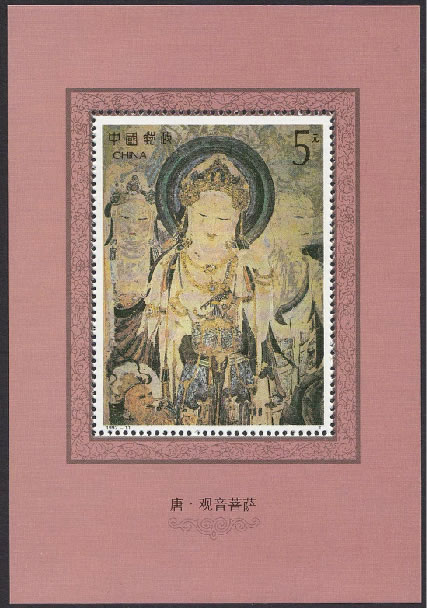 |
1992 1992-11M Dunhuang Murals (4th series) |
2,00 (with stamps together 3,00) |
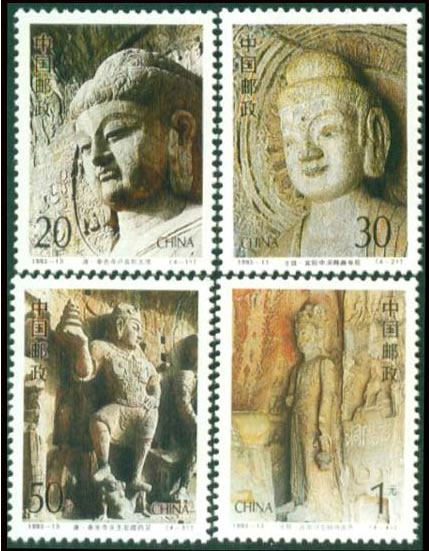 |
1993 1993-13 Longmen Grottoes The Longmen Grottoes (simplified Chinese: 龙门石窟; traditional Chinese: 龍門石窟; pinyin: lóngmén shíkū; lit. Dragon's Gate Grottoes) or Longmen Caves are one of the finest examples of Chinese Buddhist art. Housing tens of thousands of statues of Buddha and his disciples, they are located 12 kilometres (7.5 mi) south of present day Luòyáng in Hénán province, Peoples Republic of China. The images, many once painted, were carved into caves excavated from the limestone cliffs of the Xiangshan and Longmenshan mountains, running east and west. There are as many as 100,000 statues within the 1,400 caves, ranging from an 1 inch (25 mm) to 57 feet (17 m) in height. The area also contains nearly 2,500 stelae and inscriptions, whence the name “Forest of Ancient Stelae", as well as over sixty Buddhist pagodas.
|
2,00 |
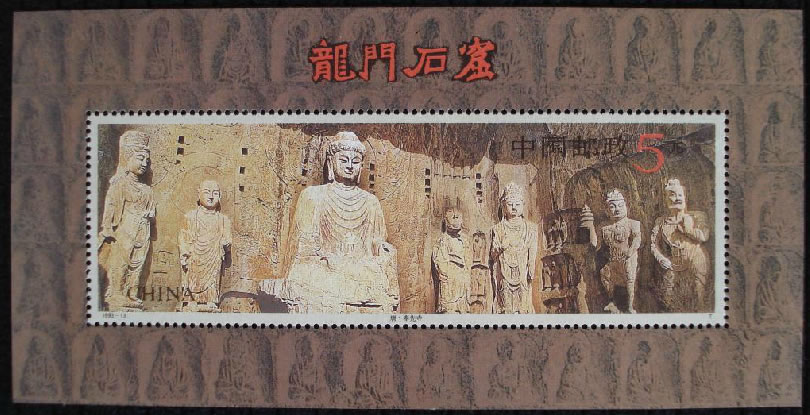 |
1993 1993-13M Longmen Grottoes
|
2,00 |
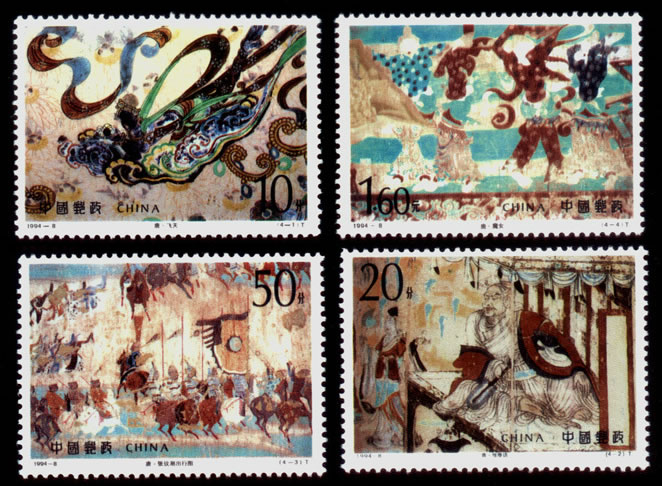 |
1994 1994-8 Dunhuang Murals (5th series) |
2,00 |
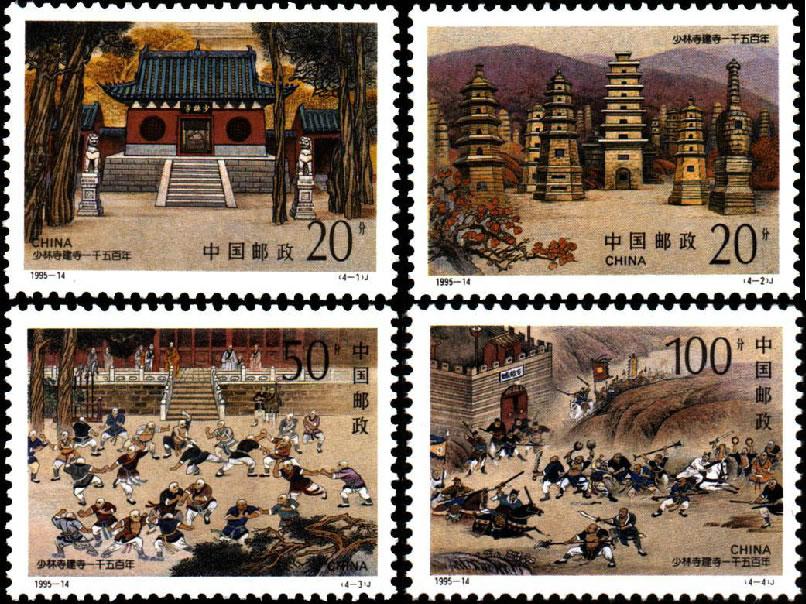 |
1995 1995-14 The 1500th Anniversary of the Shaolin Temple Shaolin Monastery or Shaolin Temple (Chinese: 少林寺; pinyin: Shàolín Sì is a Chán Buddhist temple on Mount Song, near Dengfeng, Zhengzhou, Henan province, China. It is led by Abbot Shi Yongxin. Founded in the fifth century, the monastery is long famous for its association with Chinese martial arts and particularly with Shaolin Kung Fu, and it is the best known Mahayana Buddhist monastery to the Western world. Shaolin Monastery and its famed Pagoda Forest were inscribed as a UNESCO World Heritage Site in 2010 as part of the "Historic Monuments of Dengfeng. |
2,00 |
 |
1995 1995-20 The Jiuhua Mountains Mount Jiuhua (simplified Chinese: 九华山; traditional Chinese: 九華山; pinyin: Jǐuhuá Shān; literally: "Nine Glorious Mountains") is one of the four sacred mountains of Chinese Buddhism. It is located in Qingyang County in Anhui province and is famous for its rich landscape and ancient temples. |
2,00 |
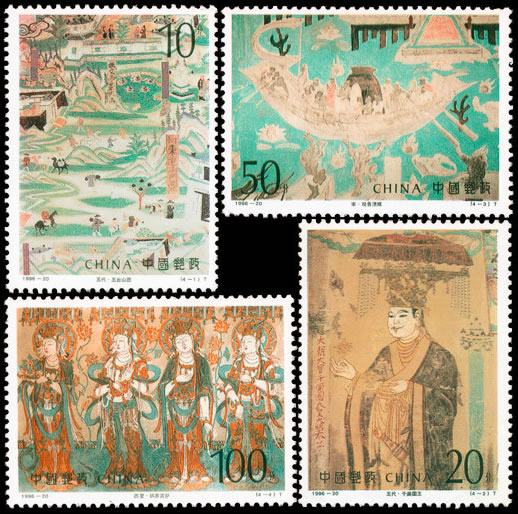 |
1996 1996-20 Dunhuang Murals (6th series)
|
2,00 |
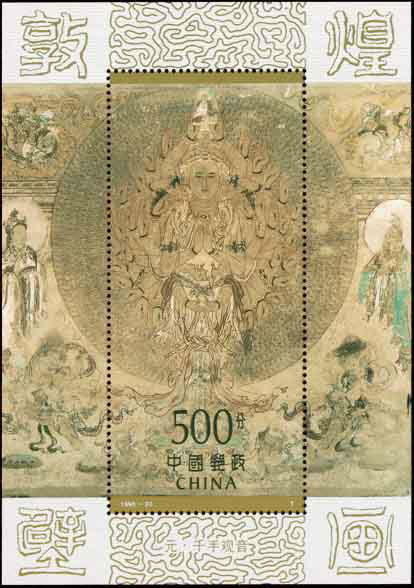 |
1996-20M Dunhuang Murals (6th series) |
2,00 |
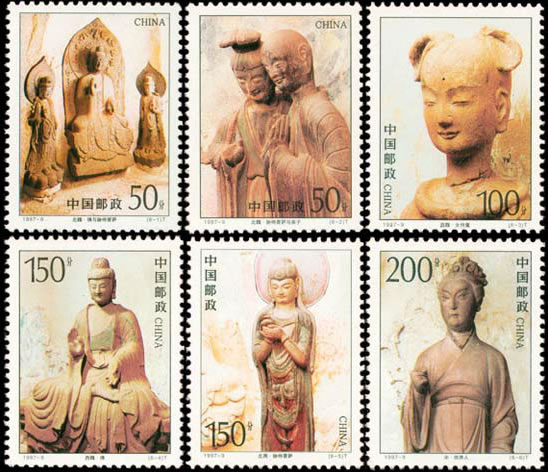 |
1997 1997-9 Maiji Grottoes The Maijishan Grottoes (simplified Chinese: 麦积山石窟; traditional Chinese: 麥積山石窟; pinyin: Màijīshān Shíkū) are a series of 194 caves cut in the side of the hill of Majishan in Tianshui, Gansu Province, northwest China. This example of rock cut architecture contains over 7,200 Buddhist sculptures and over 1,000 square meters of murals. Construction began in the Later Qin era (384-417 CE). |
2,00 |
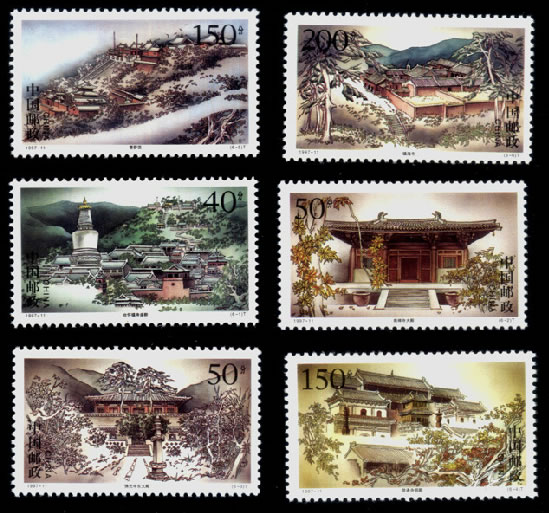 |
1997 1997-11 Ancient Temples in Wutai Mountain Mount Wutai (Chinese: 五台山; pinyin: Wǔtái Shān; literally: "Five Plateau Mountain"), also known as Wutai Mountain or Qingliang Shan, is a Buddhist sacred site located at the headwaters of river Qingshui, in the Chinese northeastern province of Shanxi, surrounded by a cluster of flat-topped peaks (North, South, East, West, and Central). The North peak, called Beitai Ding or Yedou Feng, is the highest (3.061 m), and indeed the highest point in northern China.The site is home to many of China's most important monasteries and temples. Mount Wutai host over 53 sacred monasteries, and they were inscribed as a UNESCO World Heritage Site in 2009. |
2,00 |
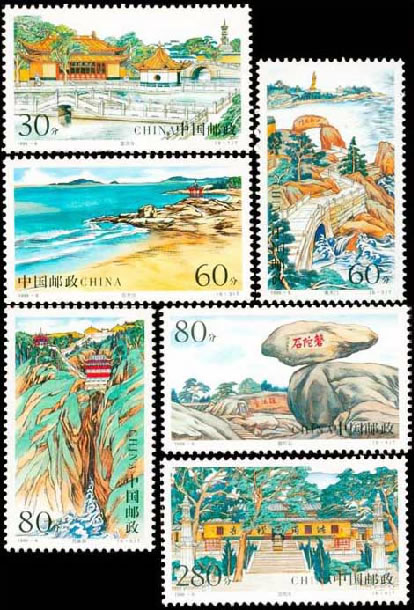 |
1996 1999-6 Beauty of Putuo Mountain Putuo Mountain in Lianhuayang to the east of Hangzhou Bay is one of the four well-known Buddhist mountains in China. After the Tang and Song dynasties Buddhism flourished and some marvelous temples were built. Putuo Mountain is famous as a Buddhist stronghold. It has many cultural and historical sites, extraordinary peaks and interesting flora. It has been a tourist and summer resort for a long time. |
2,00 |
 |
2002 2002-13 Dazu Stone Carvings The Dazu Rock Carvings (Chinese: 大足石刻; pinyin: Dàzú Shíkè) are a series of Chinese religious sculptures and carvings, dating back as far as the 7th century AD, depicting and influenced by Buddhist, Confucian and Taoist beliefs. Listed as a World Heritage Site, the Dazu Rock Carvings are made up of 75 protected sites containing some 50,000 statues, with over 100,000 Chinese characters forming inscriptions and epigraphs. The sites are located in Chongqing Municipality within the steep hillsides throughout Dazu County, located about 60 kilometers west of the urban area of Chongqing. The highlights of the rock grotto are found on Mount Baoding and Mount Beishan.The carvings were listed as a World Heritage Site in 1999. |
2,00 (sheet and stamps 3,00) |
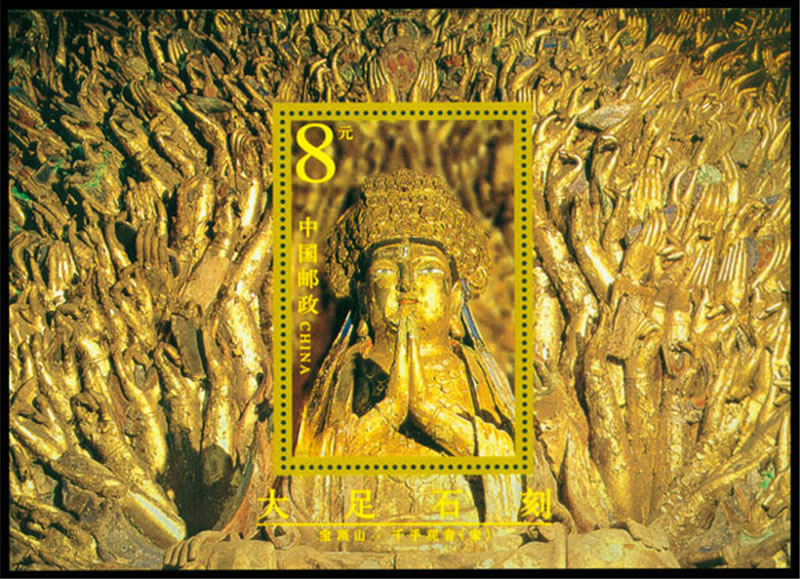 |
2002 2002-13M Dazu Stone Carvings |
2,00 (sheet and stamps 3,00) |
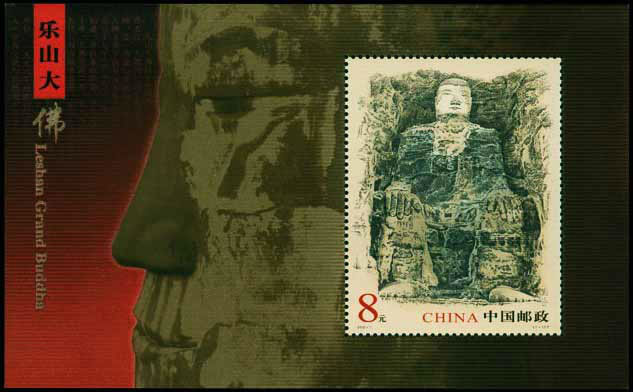 |
2003 2003-7 Leshan Giant BuddhaThe Leshan Giant Buddha (simplified Chinese: 乐山大佛; traditional Chinese: 樂山大佛; pinyin: Lèshān Dàfó) is a 71 metres (233 ft) tall stone statue, built during the Tang Dynasty. It is carved out of a cliff face that lies at the confluence of the Minjiang, Dadu and Qingyi rivers in the southern part of Sichuan province in China, near the city of Leshan. The stone sculpture faces Mount Emei, with the rivers flowing below his feet. It is the largest stone Buddha in the world and it is by far the tallest pre-modern statue in the world.The Mount Emei Scenic Area, including Leshan Giant Buddha Scenic Area has been listed as a UNESCO World Heritage Site since 1996.
|
3,00 |
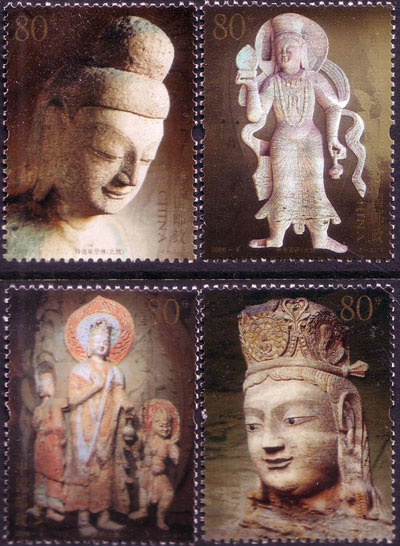 |
2006 2006-8 Yungang Grottoes The Yungang Grottoes (simplified Chinese: 云冈石窟; traditional Chinese: 雲崗石窟; pinyin: Yúngāng Shíkū; Wuzhoushan Grottoes in ancient time) are ancient Chinese Buddhist temple grottoes near the city of Datong in the province of Shanxi. They are excellent examples of rock-cut architecture and one of the three most famous ancient Buddhist sculptural sites of China. The others are Longmen (see 1993-13) and Mogao. |
5,00 |
 |
2006 2006-8 Yungang Grottoes |
3,00 |
 |
2008-16 Qiuci Grottoe Murals The Kizil (Thousand Buddha) Caves lie about 70 km (43) miles northwest of Kucha and were included within the rich fourth-century kingdom of Kucha. The caves claim origins from the royal family of ancient Kucha, specifically a local legend involving Princess Zaoerhan, the daughter of the King of Quici (Kucha). While out hunting, the princess met and fell in love with a local mason. When the mason approached the king to ask for permission to marry the princess, the king was appalled and vehemently against the union. He told the young man he would not grant permission unless the mason carved 1,000 caves into the local hills. Determined, the mason went to the hills and began carving in order to prove himself to the king. After three years and carving 999 caves, he died from the exhaustion of the work. The distraught princess found his body, and grieved herself to death, and now, her tears are said to be current waterfalls that cascade down some of the cave's rock faces. |
2,00 |
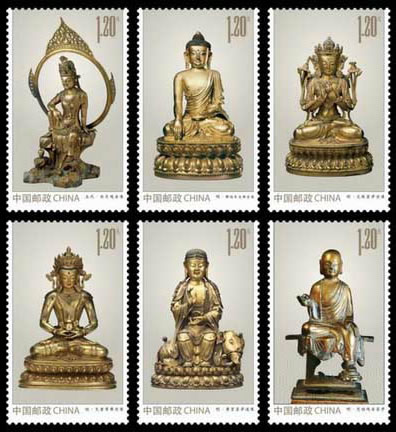 |
2013 2013-14 Gold and Bronze Buddha Statues |
2,00 (sheet and stamps 3,00) |
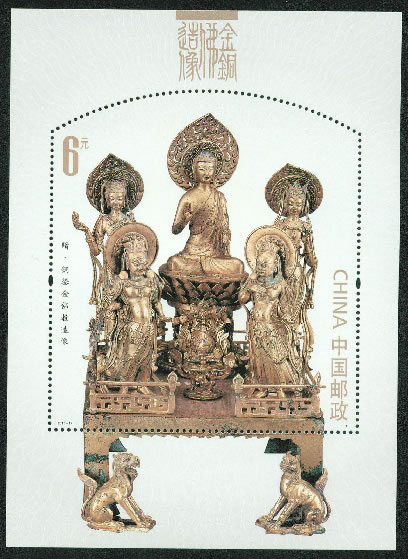 |
2013 2013-14M Gold and Bronze Buddha Statues |
2,00 (sheet and stamps 3,00) |
